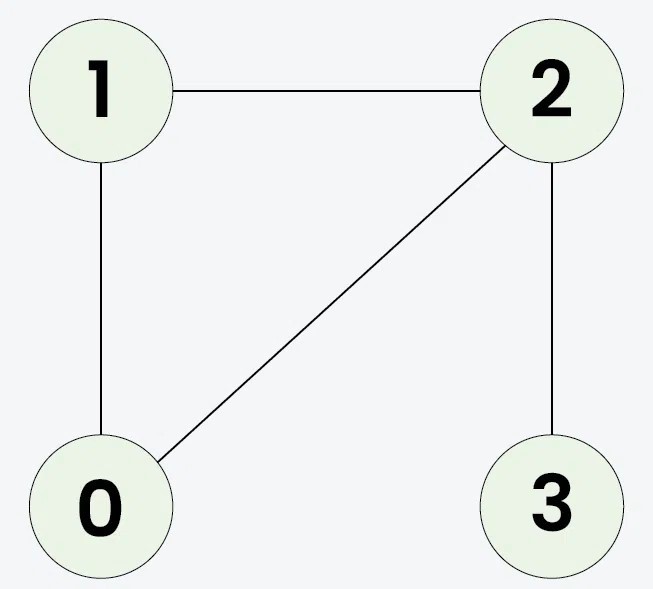Undirected Graph Cycle (DFS | BFS)
 Chetan Datta
Chetan DattaProblem
Given an undirected graph with V vertices and E edges, represented as a 2D vector edges[][], where each entry edges[i] = [u, v] denotes an edge between vertices u and v, determine whether the graph contains a cycle or not. The graph can have multiple component. (geeks link)
Examples:
Input: V = 4, E = 4, edges[][] = [[0, 1], [0, 2], [1, 2], [2, 3]]
Output: true
Explanation:

1 -> 2 -> 0 -> 1 is a cycle.
Input: V = 4, E = 3, edges[][] = [[0, 1], [1, 2], [2, 3]]
Output: false
Explanation:

No cycle in the graph.
Constraints:
1 ≤ V ≤ 105
1 ≤ E = edges.size() ≤ 105
Solution
Idea: It's simple. We use the traversal technique BFS/DFS. If we find that a node is already visited, then there is a cycle. Otherwise, there isn't. Note that we exclude checking the parent node because, in an undirected graph, we can also go back along the same edge.
BFS
class Solution {
public boolean isCycle(int V, int[][] edges) {
List<List<Integer>> adjList = createAdjList(V, edges);
int[] visited = new int[V];
for(int vertex=0; vertex<V; vertex++){
if(visited[vertex]==0 && bfs(vertex, adjList, visited)){
return true;
}
}
return false;
}
public boolean bfs(int i, List<List<Integer>> adjList, int[] visited){
Queue<Pair<Integer, Integer>> queue = new ArrayDeque<>();
queue.add(new Pair<>(i, -1));
while(!queue.isEmpty()){
Pair<Integer, Integer> pair = queue.poll();
int node = pair.vertex;
int parentNode = pair.parentVertex;
visited[node] = 1;
for(int edgeVertex : adjList.get(node)){
if(edgeVertex == parentNode){
continue;
}
if(visited[edgeVertex]==0){
queue.add(new Pair<>(edgeVertex, node));
visited[edgeVertex] = 1;
}
else{
return true;
}
}
}
return false;
}
private List<List<Integer>> createAdjList(int V, int[][] edges){
List<List<Integer>> adjList = new ArrayList<>();
for(int i=0; i<V; i++){
adjList.add(new ArrayList<>());
}
for(int[] edge : edges){
adjList.get(edge[0]).add(edge[1]);
adjList.get(edge[1]).add(edge[0]);
}
return adjList;
}
class Pair <A, B>{
A vertex;
B parentVertex;
Pair(A vertex, B parentVertex){
this.vertex = vertex;
this.parentVertex = parentVertex;
}
@Override
public String toString() {
return "Pair{" +
"vertex=" + vertex +
", parentVertex=" + parentVertex +
'}';
}
}
}
DFS
class Solution {
public boolean isCycle(int V, int[][] edges) {
List<List<Integer>> adjList = createAdjList(V, edges);
int[] visited = new int[V];
for(int vertex=0; vertex<V; vertex++){
if(visited[vertex]==0 && dfs(vertex, -1, adjList, visited)){
return true;
}
}
return false;
}
public static boolean dfs(int i, int parentVertex, List<List<Integer>> adjList, int[] visited){
if(visited[i]==1){
return true;
}
visited[i]=1;
for(int adjVertex : adjList.get(i)){
if(adjVertex != parentVertex && dfs(adjVertex, i, adjList, visited)){
return true;
}
}
return false;
}
private static List<List<Integer>> createAdjList(int V, int[][] edges){
List<List<Integer>> adjList = new ArrayList<>();
for(int i=0; i<V; i++){
adjList.add(new ArrayList<>());
}
for(int[] edge : edges){
adjList.get(edge[0]).add(edge[1]);
adjList.get(edge[1]).add(edge[0]);
}
return adjList;
}
}
Subscribe to my newsletter
Read articles from Chetan Datta directly inside your inbox. Subscribe to the newsletter, and don't miss out.
Written by

Chetan Datta
Chetan Datta
I'm someone deeply engrossed in the world of software developement, and I find joy in sharing my thoughts and insights on various topics. You can explore my exclusive content here, where I meticulously document all things tech-related that spark my curiosity. Stay connected for my latest discoveries and observations.